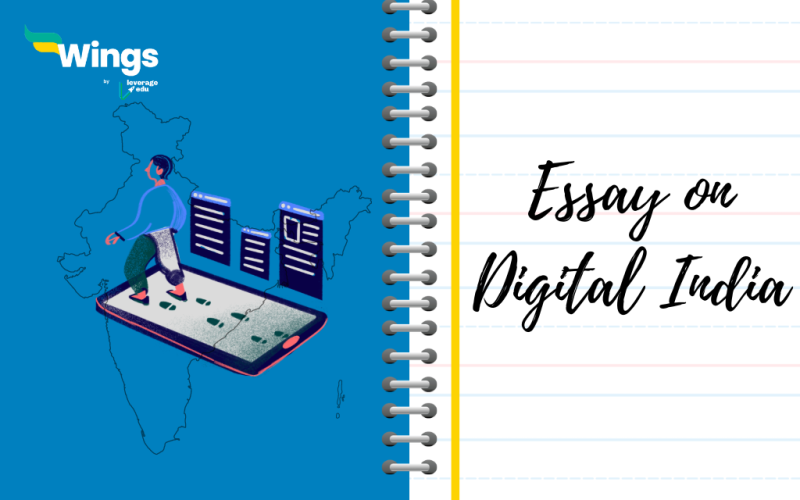Essay on Digital India: Digital India is a flagship program launched by the government of India on 1st July 2015. This programme aims to transform India into a digitally empowered society. To do this, the government has launched several initiatives and regional sub-schemes, such as the Digital India Mobile App, Digital India Portal, e-Governance, etc. Today, we will discuss some essay on digital India in 100, 200 and 500 words.
Master the art of essay writing with our blog on How to Write an Essay in English.
Table of Contents [show]
Essay on Digital India in 100 Words
Digital India is a central-government-backed scheme, launched in 2015. Prime Minister Narendra Modi launched this scheme to transform India into a digitally empowered nation. This scheme will bring digital revolution to the entire country by providing easy access to digital services in remote and rural areas.
The government launched several sub-schemes to support the digital revolution, such as the Digital India Portal, the National Optical Fibre Network, the National e-Governance Plan, etc. The Digital India scheme encompasses three key vision areas:
- Digital infrastructure is a core utility to every citizen.
- Governance and services on demand.
- Digital empowerment of citizens.
All the focused areas will benefit the consumer as well as the service providers. With the sub-schemes launched, the government will also provide access to WiFi connectivity in public places and government schools. This will make e-learning and online education accessible to everyone.
Also Read: Essay on Peer Pressure in 100, 200 and 350 Words
Essay on Digital India in 200 Words
The government of India launched the Digital India scheme in 2015 to transform the country into a digitally empowered and economically advanced nation. This flagship scheme was launched at the Indira Gandhi Indoor Stadium, Delhi. The country’s top industrialists, such as Cyrus Mistry (Former Chairman of Tata Group), Mukesh Ambani (Chairman and Managing Director of Reliance India Ltd.), Wipro’s Chairman Azim Premji, and others were present.
About the Digital India Scheme
The government of India conducted a meeting of top-level industrialists and government officials to discuss the digital transformation of the country. The purpose of the meeting was the bring a digital revolution in India by making government services accessible to the remotest areas of the country.
The government has invited private organisations to invest in the Digital India scheme. The execution cost of this flagship project was 1 lac crore rupees. This money was invested to develop government services and digital platforms so that people living in rural areas can have easy access.
Aim of Digital India
The aim of Digital India is simple; digital transformation of the national economy. However, to support this national-level scheme, the government has launched several parallel projects or sub-schemes. These schemes are:
- National e-Governance Plan
- Digital India Mobile App
- Digital India Portal
All these sub-schemes will benefit the rural population, who have no access to the internet and government services. With its online learning and e-health platforms, the government has provided people with educational platforms, where people, especially rural people, can learn and benefit from government schemes.
Also Read: Essay on the Importance of Internet
Essay on Digital India in 500 Words
India is undergoing a digital revolution with the Digital India initiative, launched by the Government of India on 1st July 2015. This ambitious program aims to provide fast and affordable internet access, digital governance, and online public services to every Indian citizen. With rapid technological growth, Digital India is shaping the country into a digital powerhouse.
Objectives of Digital India
The main objectives of Digital India include:
- Providing digital infrastructure – Ensuring every citizen has access to high-speed internet, especially in rural areas.
- Enhancing digital services – Promoting paperless governance and e-Government services through platforms like UMANG, e-Hospital, and DigiLocker.
- Increasing digital literacy – Educating people, especially in villages, on how to use online services safely and efficiently.
Major Schemes under Digital India
Several programs have been launched to support the Digital India initiative:
- BharatNet: Provides broadband connectivity to rural areas.
- PMGDISHA (Pradhan Mantri Gramin Digital Saksharta Abhiyan): Aims to make six crore rural households digitally literate.
- UMANG (Unified Mobile Application for New-age Governance): Offers multiple government services in one mobile app.
- e-Hospital: Enables online registration and appointment booking at government hospitals.
- DigiLocker: Provides a digital platform to store and share important documents.
Impact on Education and Economy
The digital revolution has greatly impacted education. Students can now study through e-learning platforms like Swayam and Diksha, which offer free online courses. The PM eVidya program has also helped students access digital education across different states.
In the financial sector, UPI (Unified Payments Interface) has transformed transactions, making India one of the largest cashless economies in the world. Apps like Google Pay, PhonePe, and Paytm allow instant money transfers, benefiting small shopkeepers and businesses.
Challenges and the Way Forward
While Digital India has seen great success, some challenges remain. Many remote villages still lack stable internet connections. Cybersecurity threats and digital frauds are also rising, requiring stronger security measures.
To make Digital India fully successful, the government must ensure affordable internet, strengthen cybersecurity laws, and educate people about digital safety. With continuous improvements, India is on its way to becoming a truly digital nation.
Conclusion
Digital India is more than just a program—it is a vision to transform India into a digitally empowered society. With initiatives in online governance, education, finance, and healthcare, this program is changing lives across the country. As technology advances, Digital India will continue to drive progress, making India a global leader in the digital era.
Also Read: Essay on Contribution of Technology in Education for School Students
FAQs
Ans: Digital India is a central-government-backed scheme, launched in 2015. Prime Minister Narendra Modi launched this scheme to transform India into a digitally empowered nation. This scheme will bring digital revolution to the entire country by providing easy access to digital services in remote and rural areas.
Ans: The Digital India scheme was launched by Prime Minister Narendra Modi on 1st July 2015.
Ans: The Digital India scheme will provide easy access to e-learning and e-health services to students. Students living in rural areas can have access to online classes, study materials and video lectures. Students can access internet services and social media platforms, which will help them connect with the rest of the world and learn about new trends.
Ans: The main purpose of Digital India is to make government services available online, improve internet access, promote digital payments, and enhance digital literacy across India, especially in rural areas.
Ans: Digital India has made life easier by introducing online services like UPI payments, DigiLocker, e-Hospital for medical appointments, and BharatNet for rural internet access. It has also improved education through online learning platforms like Swayam and Diksha.
Ans: Some important schemes under Digital India include BharatNet (providing rural internet), PMGDISHA (digital literacy program), UMANG (government services app), DigiLocker (online document storage), and e-Hospital (online healthcare services).
Related Articles
For more information on such informative articles for your school, visit our essay writing page and follow Leverage Edu.
 One app for all your study abroad needs
One app for all your study abroad needs















 45,000+ students trusted us with their dreams. Take the first step today!
45,000+ students trusted us with their dreams. Take the first step today!
